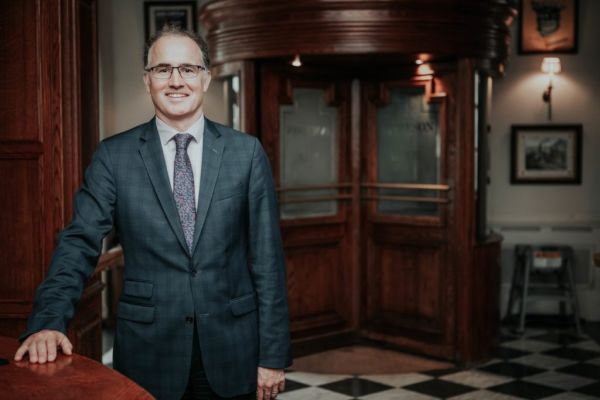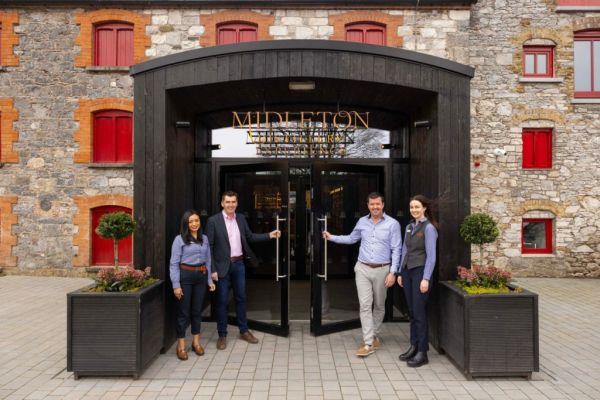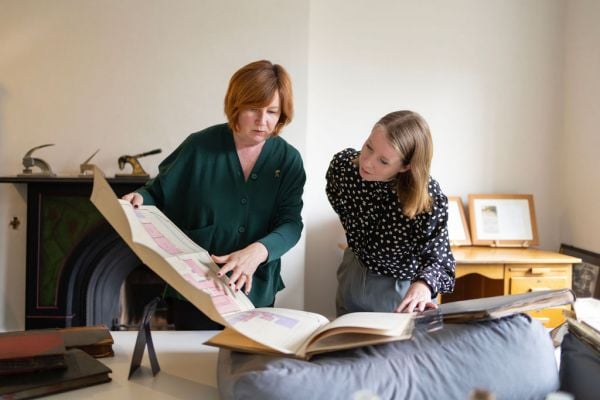Robert McHugh catches up with William Kirby, general manager at Portmarnock Resort & Jameson Golf Links, ‘once the family home of the Jameson dynasty.’
Portmarnock Resort & Jameson Golf Links is situated on a beautiful stretch of uninterrupted coastline aptly known as the Velvet Strand.
The long association between the Jameson family and Portmarnock begins when John Jameson III, the grandson of the founder of the Jameson Distillery at Bow Street, moved to St Marnock’s in 1847. He and his wife, Anne, had five children, the youngest of whom, Willie, was born in the house in 1851.
Jameson brought with him two impressive portraits of his grandparents, John and Margaret Jameson, by the Scottish artist Sir Henry Raeburn. These portraits are now on display at the National Gallery of Ireland, while reproductions hang in the hotel bar.
The resort has an award-winning links course and spa, and three dining outlets, including the well-known Jameson Bar.
Portmarnock Resort & Jameson Golf Links first opened for play in 1995. Located just 15 minutes from Dublin Airport, it is popular for anyone looking to enjoy a break from the city.
Jameson Golf Links is an 18-hole course spread across 203 acres and set on the grounds of the old Jameson Estate of St Marnock’s. The course has played host to professional and amateur events, including the 2008 and 2009 Women’s Irish Open and the 2021 Irish Challenge. The course makes full use of the dunes and natural terrain, for an exciting play, and includes elevated tees and greens, blind approaches, and dog-legs.
Hospitality Ireland decided to catch up with William Kirby, general manager at Portmarnock Resort & Jameson Golf Links, to find out what it is like to be in charge of one of the most impressive resorts in Europe and his exciting plans for the future.
What was your first job in the hospitality industry, and how did that experience shape your passion and commitment to the field?
My first real job – as a management trainee, doing all the front-of-house departments – was at the Old Course Hotel [in St Andrews].
I went to my college placement in St Andrews in 1988, and I graduated in 1990. I went back there because of the Open Championship, to get Open experience.
I did all sorts of jobs – night audit, porter, receptionist.
Who was your first mentor in hospitality, and how did his/her/their guidance influence your growth and development as a hospitality professional?
Willy Bauer was the managing director of the Savoy and the chief executive of the Wentworth Group. He passed away a couple of years ago. He was my mentor at the Westbury, which was great because he was Savoy trained.
My GM at the Balmoral [Hotel], Guy Crawford, was also a key mentor during the early nineties. He then became CEO of the Jumeirah Group. I kept in touch with him, too.
Those two are pretty high up as mentors. I certainly knew how to change a light bulb and fix a carpet, but I learnt a lot more of the attention-to-detail stuff from them, aside from that.
Could you walk us through the various roles that you have held in your career?
There was a bit of a mass exodus from St Andrews because, at the time, the Balmoral was opening in Edinburgh, so everybody wanted to go to the heady heights of the big city. I took a demotion and went to work there as a receptionist in 1991.
I stayed on there and Forte [Group plc] took the property on a management contract after that, so I stayed there until 1995, and then I got a job within the Forte Méridien chain in London – the Westbury Hotel. I stayed there for three years as hotel manager, and then I went to work at the Buckinghamshire Golf Club, just outside London – Uxbridge. I was there as club secretary/deputy general manager – that kind of role.
Then I went up to the Roxburghe, in Kelso, as general manager. It is owned by the Duke of Roxburghe, and he built a fantastic championship golf course up there, too. I was there for six years and started a family while there.
Then I got a job as GM at Mount Juliet in 2006, with the Conrad brand of Hilton, and stayed there until 2014. I then spent a year at a large conference hotel in Kilkenny, and then moved as GM to Lough Erne, in Northern Ireland. The golf resort had one of Nick Faldo’s signature courses there, which was part of the attraction. I then moved south, back closer to home, in 2020, when I moved to Portmarnock Resort.
Of which industry networks have you been a part that have provided vital support and contributed to your career progression?
I’m not a complete industry network buff. I’ve dabbled in the IHF [Irish Hotels Federation] over the years. Some years you get really involved in it, some years you kind of stay on the periphery. I’m a member of the IHF. I’ve been a Rotarian for years as well, mostly in Kilkenny. I got nominated for an Acorn Award back in the day.
In terms of Chambers of Commerce, I’ve been very heavily involved in the ones in Edinburgh and Kilkenny. I think the IHF, Fáilte Ireland, golf tourism advisory boards, Chambers of Commerce – they’re the main ones that you get immersed in.
In your experience, what are the most significant challenges that you have faced while working in the hospitality industry, and how did you navigate them?
During the Gulf War, there were lots of redundancies, but I was younger then, and I wasn’t bothered about getting a job because I was young enough and stupid enough to just go and get one, but when you’ve got a family, it’s a bit hairier.
The crash of 2009 and 2010 – that was tough because you had to make a lot of redundancies and rebuild a business. I was at Mount Juliet at the time.
In terms of going up to Fermanagh [Lough Erne], Northern Ireland was a very tough gig because the employment market up there is pretty horrendous. Covid, followed by the crash, and trying to run a business in a tough geographical region … I’ve run businesses that have been struggling financially, and I’ve got them to a level where they’re sustainable – that’s what we achieved at Mount Juliet and Lough Erne.
Portmarnock was a real journey because, following the ownership change, the property was hit, like all businesses, with Covid. I had to make some tough decisions almost immediately, to ensure the business was sustainable during that period. Three and a half years on, the team is being rebuilt, and business levels, thankfully, are back to something like normal, albeit a long way to go.
They were the tougher parts of my career, and some smaller-detail ones relating to me, personally, I had to deal with at the time. Some of the HR stuff was pretty harrowing, but that’s part of the job, isn’t it?
Recruiting people post-Covid has been a nightmare. It’s not easy getting people in and staying in, so we’ve had to be quite smart about where we get our talent from.
It was during Covid – it was like, ‘If you want to work, we’ll pay you and we’ll figure out the rest later.’ I couldn’t get a chef a year and a half ago. Now I’m a bit better placed, but I never say I am sorted.
Looking ahead, what are your career goals and aspirations, and how do you envisage making a lasting impact on the hospitality sector?
I’ve got tangible ones and non-tangible ones. The non-tangible ones are realising the ambitions of the brand. We aspire to be the best resort in our geographical location. Does that mean we’re going to be a five-star resort? I’m not a big one for classification – I never have been.
I want to be the best resort in this area and that says, ‘OK, well, what does that mean?’ It’s luxury, it is service/delivery, it is things that you can touch and feel. Customers, though, still gravitate to five-star [properties], four-stars, so it is not something you can ignore. It is just an opinion.
The Jameson brand – that will be a journey. We’ve obviously got some commercial strategy that we want to realise for the next three or four years. We want to be looking at tournament golf at some point in the future. I’m not sure that will come, but we’re in the spotlight, as are our quiet neighbours next door. I’d be surprised if this piece of land doesn’t have a big tournament in the next three to four years.
Whether that means Portmarnock Golf Club secure the Open in the next five to six years, nobody knows that answer, apart from them and the R&A [Royal & Ancient Golf Club of St Andrews], but if we’re hanging on the coat-tails of that, then we are going to be right in the spotlight. If we get the chance to do a tournament with this new-layout tour – let’s call it a world tour programme – then, equally, that will put us on the map as well.
Personally, I’ve been here nearly four years now, so I can’t see myself moving around again. If things keep developing here, it’s a great brand to work with, and our owners are very supportive. As long as I’m delivering what they want and I’m delivering, personally, what I want to deliver as well, then it’s a good marriage.
I don’t anticipate going off to Thailand to finish my career, or China or America. I’ll keep developing, but I’m pretty settled in Kilkenny.
I’m not in my twilight years yet, but I’m not a 20-year-old looking to get his foot on this first rung of the ladder, either!








